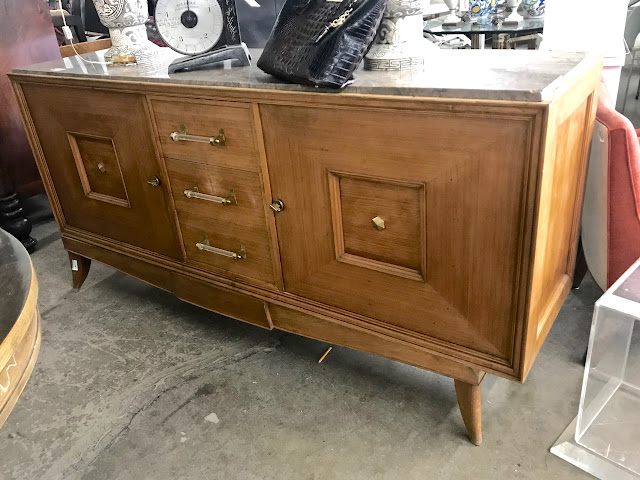Just when I thought that I would have to start worrying about acquiring inventory, God blesses me with an amazing piece.
This gorgeous French(?)/Italian(?)......I'm leaning French, Buffet was added to the auction at the last minute, meaning that there wasn't time to advertise it. This is always a good sign!! And they had positioned the buffet to be auctioned off early--before the crowds showed up (very good sign). Here are a couple of more more shots
Notice the broken marble? That might also have served as a deterrent.... You can bet that I planned to be at auction early on Thursday.
Thursday Morning (drum roll): I'm there ready and waiting for the sideboard/buffet. Some one else opens the bidding and then I bid. Three of us on the floor plus an absentee bidder go back and forth for a while. The bidding slows down at about $1000 (the absentee bidder drops out). Then the bidder to my right drops out. I bid my top limit amount against the bidder to my left.....and I wait and wait as the auctioneer tries to get a bid from the other bidder (I hate this part of bidding--you are on pins and needles until the hammer drops)......the buffet was ALL mine. (Just needed to pay)
This gorgeous late 1940s/early 1950s buffet is beautifully constructed of solid mahogany in the French manner. The original hardware is of finely cast solid brass and lucite. The fielded form of the paneled doors highlighted with brass stars is super refined. And look at those amazing feet! .....It has all of the bells and whistles that make me happy.
Roberto is picking this handsome guy up tomorrow and he thinks that he can fix the marble. It would be about $600 to replace the marble.
MORE--very early Fortuny. I cannot believe that I have been able to acquire two early 20th century Fortuny textile fragments in less than a month. When this happens I am elated (quietly jumping up and down) as I know that I'm listening and that God is blessing me.
This Fortuny fragment dates to the late 1920's, perhaps early 1930's and bears the early Fortuny mark
The reverse of a Fortuny textile is often more indicative of the time frame of the piece than the front and frequently the fragment is not a section of the length that has been stamped. The more common 1920's pieces are almost completely black on the reverse. This rare red example is a very saturated red on the reverse, which is also an indication of it being a hand made textile.
FINALLY----The Karl Springer table's top has been delivered and is ready to go home with its new owner...
I wonder when we are going to manage to get to autumn? It's been super hot here.....I can't wait for sweater weather. And I am not ready for Christmas music.
Sending blessings for the coming week.
Mary & Cole










This comment has been removed by a blog administrator.
ReplyDelete